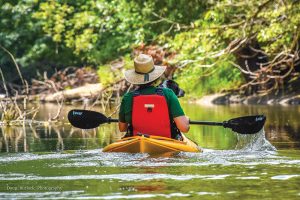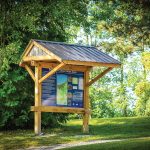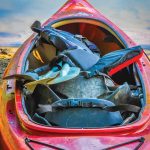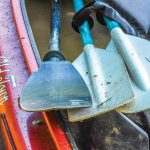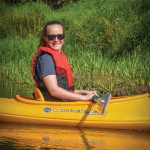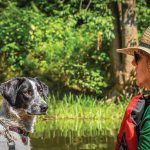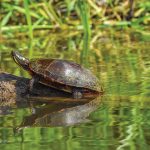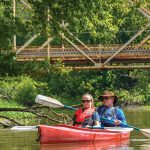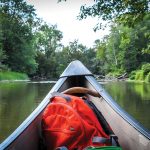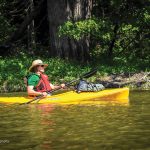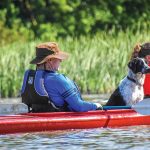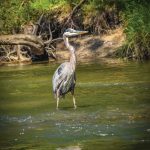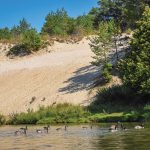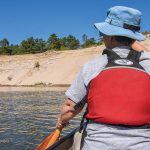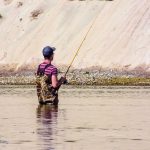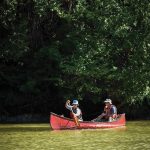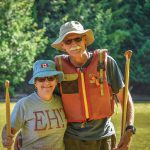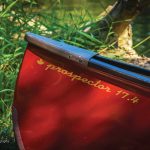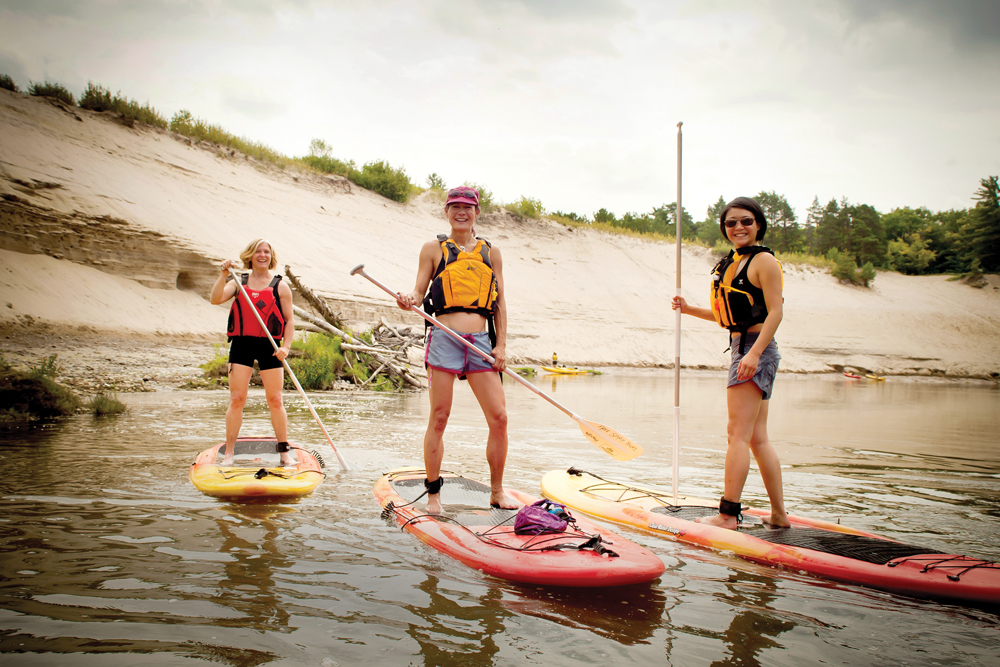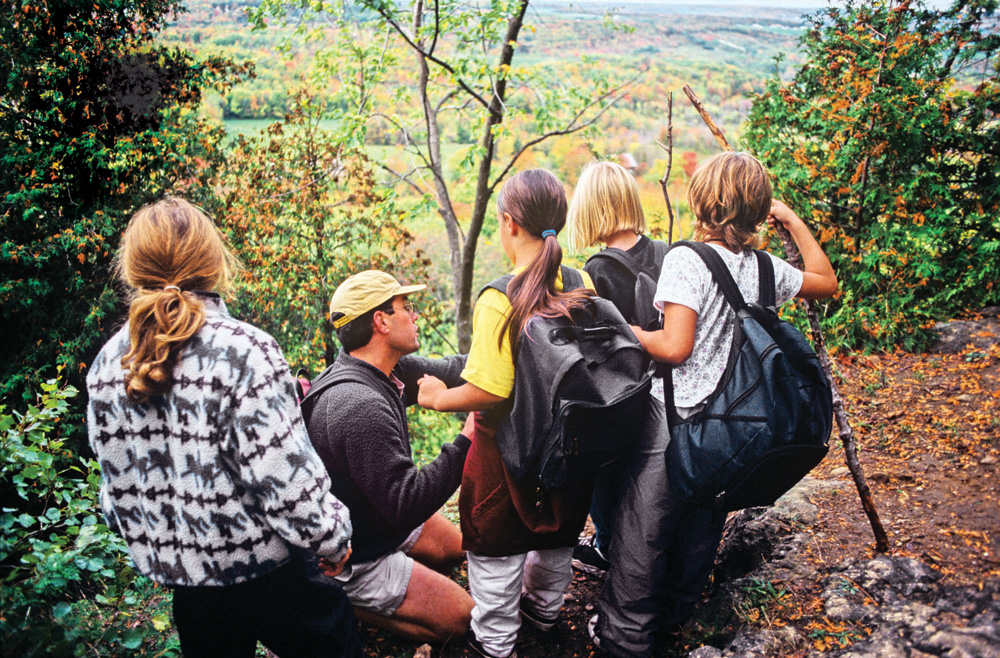A paddling trip along the Nottawasaga River
by Laurie Stephens
photography by Doug Burlock
It’s a bright, warm morning at Edenvale Conservation Area, a little oasis just off of Highway 26 east of Stayner. A few canoes are stacked at the put-in, and a couple of fishermen stand at the shoreline, their lines in the water.
Our group of experienced recreational paddlers – in a canoe, a tandem kayak and a solo kayak – is about to embark on a 23.5-kilometre trek down the Nottawasaga River to Schooner Town in Wasaga Beach. The day is perfect for the trip: about 20°C with little wind.
In one canoe are Rick Goldenhar, and Leslie Piercey and their dog Dixie, a cattle dog mix that loves the water. I occupy the bow in another canoe, and my spouse, Rick Floether, steers from the stern. Our daughter, Maddie Floether, hops into the kayak. Combined, we have almost 150 years of paddling experience through lakes and rivers in provincial parks and Crown land across the province.
At 10:40 a.m., we push off into the river, the water a greeny-brown and so opaque you can’t see to the bottom. It’s impossible to tell its depth.
But the surface is flat, and in the absence of ripples, we can see our reflections as we begin our paddle.
The narrow river snakes back and forth, and within moments of our launch, we are transported into another world filled with the sights, sounds and smells of river life. The banks are lined with maple and birch trees, and the muddy shores are dotted with holes that house all manner of river critters. It is so calm and peaceful, it reminds me of pictures I’ve seen of the Louisiana bayou.
There are birds galore: swallows flit across the surface, some sort of large raptor scouts for prey from a tree top, and up ahead, a great blue heron effortlessly lifts its bulk out of the water as we approach. The water smells fishy in places, drawing turkey vultures looking for a meal.
There are plenty of downed trees in the river, and we spot a small snapping turtle and larger painted varieties sunning themselves as we paddle through this section.
Every once in a while, Dixie jumps out of Rick and Leslie’s kayak and swims to the bank, where she darts ahead of our flotilla, running off excess energy.
We are in paradise.
The Nottawasaga River, affectionately referred to by locals as “the Notty,” is rich in history, ecological diversity and beauty.
The river is a tributary of Lake Huron that flows from Orangeville through the Niagara Escarpment, the Minesing Wetlands and past seven magnificent sand dunes before emptying into Nottawasaga Bay at the town of Wasaga Beach.
“A word that we always use to describe the Nottawasaga is majestic,” says Jennie Elmslie, co-owner of Free Spirit Tours, a 20-year-old company that offers guided paddles down the river. “It’s wide, has lots of history and lots of wildlife, fish and birds. The thing about the Nottawasaga River is that people are passionate about it. Whether they fish on it, whether they paddle on it, people love that river.”
The river is also significant from a historical perspective. It served as a key information and supply route for the British during the War of 1812, and was also a naval battleground.
On August 14, 1814, American troops sailed into Nottawasaga Bay on three ships – Niagara, Tigress and Scorpion – looking for the British supply ship Nancy. The Nancy’s commander, realizing he was over-matched, scuttled the ship near the mouth of the river so that her valuable cargo could not be captured by the enemy.
Even though the Nancy was sunk, physical evidence of her historical role is preserved: an island formed around her remains (close to Wasaga Beach’s Edgewater By the Bay motel) and her hull has been preserved in a museum at the Nancy Island Historic Site.
The Notty’s history is of keen interest to Richard Bowering, 76, the founder of Eagle Adventures, another paddling excursion company, based out of Ravenna. A local history buff, Bowering delivers customized river paddles with guides well-versed in the history of the area.
“We embellish all of our trips with all of this information,” he says. “We put together a team of guides and we suggest a route. We’re the custom people in the area: we focus on giving you an experience.”
After a couple of hours of paddling, we are ready for lunch, and we look for a suitable place to land the boats and eat. We’ve packed coolers with sandwiches, vegetables and dips, fruit and snacks. We paddle under a bridge and past a few areas on shore that are ideal but already occupied by other canoeists. Then we spot a flat, shady surface that we think might work.
It’s a strategic error. The shore is way too muddy, and when we step out, we’re up to our ankles in muck. What’s more, the shade has drawn pesky mosquitoes in droves. So we make the decision to get back out on the river, paddle a bit to lose the bugs, then draw our canoe and kayaks together, passing food back and forth for an impromptu picnic on the water.
This section of the river is not as quiet as where we put in. We have run into the occasional group of paddlers, a few people fishing, and lots of kingfishers hunting for their lunch. The banks rise up into farmers’ fields, and a couple of country road bridges span the river, huge wasp nests hanging from the trusses. Every once in a while, we hear vehicles on the bridges above as they cross over the water.
Still, it is peaceful. There is still no wind and the sun is now blazing. The water isn’t as murky, and we sometimes catch a glimpse of a fish.
Lunch done, we check the map and GPS and realize we still have a lengthy paddle ahead of us. So, fuelled up, we pack away the coolers and pick up our pace for the rest of the journey.
Bowering is a former business executive and high school teacher who moved to Ravenna full-time five years ago. He has been a paddling guide for 45 years. In addition to running a successful guest house in Ravenna, he founded Eagle Adventures 13 years ago and now has five full-time employees, plus a pool of eight experienced guides who offer half-day or full-day experiences, which are customized for each group and flexible in terms of time spent on the water.
“We don’t split hairs,” he says. “We have a route that’s designated a half day and sometimes people take four hours on it. We don’t care.”
Eagle Adventures delivers canoes, kayaks (including tandems) and guide services to 16 put-ins all along the Nottawasaga, starting at Alliston. The company’s clientele is largely female and over 30, says Bowering, ranging from couples to larger groups of women or men enjoying weekend getaways or bachelorette parties.
In addition to river paddles, Eagle Adventures also delivers skills training for kayakers and canoeists and offers all kinds of outdoor experiences year-round, including snowshoeing, hiking, biking and rock climbing.
Bowering keeps his head in the paddling game by spending time on the water himself. Over the years, he’s tripped all over Ontario and even paddled in Alaska. This fall, he is planning a two-week kayak trip in Iceland, where the weather can be finicky. “On the days I can paddle, I am going to paddle; on the days I can’t, I’ll be in a hot pool,” he laughs.
Free Spirit Tours, owned by Jennie Elmslie, is another company that offers year-round outdoor experiences. The company is celebrating 20 years of operation this summer with the opening of a new “Notty River Base” at Schooner Town that has paddling gear and washrooms for paddlers coming off the river.
The company delivers one-hour (put-in at The Oxbow), two-hour (put-in at Klondike Park) and four-hour (put-in at Hamillville) tours led by experienced guides. The tours operate from May to Thanksgiving, mostly on weekends in May, June and September and seven days a week in July and August.
“For people who are not really comfortable, if they’ve never been in a kayak or a canoe before, we would recommend going with a guide,” says Elmslie. “But if you’ve paddled before and you’re comfortable in a canoe or kayak, you can do it on your own. You can’t get lost; you just follow the river.”
Different guides have different areas of knowledge – one really knows bird life, another knows the history of the area, she says. When not guiding, they themselves are on the river, “doing what they are passionate about.”
The one- and two-hour paddles take in the lower part of the river and the parabolic sand dunes. The four-hour tour puts in at the steel bridge in Hamillville and is a lovely paddle, says Elmslie. “You get to go through Jack’s Lake, which is amazing because there’s an active bald eagle’s nest there and there are swans that live there. Going through Jack’s Lake is really special.”
About two-thirds into our paddle, we arrive at Jack’s Lake: a small, irregularly shaped body of water that is teaming with wildlife. We see our first cormorants, perched in trees on the lake’s edge, and a blue heron at water’s edge slowly moves into the brush to hide from our prying eyes.
Our group spends some time here, taking in the view, looking for wildlife and slowly exploring a few nooks and crannies of the lake, feeling like interlopers as we disturb some ducks. Areas of the lake with dense reeds reveal narrow travel routes likely carved by otters or beavers, but we see no sign of them on this day. The sun is high in the sky, and they are likely taking a siesta.
This place is clearly a fisherman’s paradise. Through the reeds we spot a boat puttering slowly around a small cove off the main lake with lines in the water. But we’ve come without fishing poles, so we slowly make our way out of the lake and back onto the river.
At this point, the Notty takes on a whole new personality. For the first half of our trip, the river was exceedingly calm and opaque. Past Jack’s Lake, however, it is a far different experience.
Here the river is wider, the current picks up significantly and the water runs clear. The mosquitoes that necessitated bug repellant at the beginning of the trip are not in evidence here. We come upon a large trailer park and greater numbers of people fishing – a sign that we are getting closer to more developed areas of the river and our ultimate destination, Schooner Town.
Soon we hear the sound of rushing water, and around a bend we encounter the first of a series of ‘swifts’ – sections of fast-running water – that shake off our serenity. Fortunately, water levels are high and the currents aren’t severe – certainly not full-blown rapids.
We halt for a moment to chart the best path through the boulders that could prove treacherous if we were to hit them. Then we enter the turbulent waters and I concentrate hard on avoiding any obstacles ahead. As we run with the current, bobbing and weaving past rocks, the speed of our travel is both startling and exhilarating.
My heart is pounding.
These swifts play a key role in water quality, says Fred Dobbs, manager of stewardship services at the Nottawasaga Valley Conservation Authority (NVCA). Fast-flowing sections of the Nottawasaga River, such as the Montgomery Rapids, occur where there is a change in elevation in the river.
“The water’s actually dropping and tumbling over rock, and that’s a really important driver for the system in terms of improving water quality,” he says. “The flat sections of river, like where you started in Edenvale, don’t tend to respond well to nutrient inputs. But water quality improves as it goes downstream adjacent to Wasaga Beach Provincial Park – it would go through areas where the water is tumbling and oxygenated and the bed of the river is filled with filter-feeding animals like native river mussels.”
Because the river is a significant spawning ground for rainbow trout, Chinook salmon and lake sturgeon – not to mention rich in aquatic animals and birds – the NVCA continually monitors the water quality of the Nottawasaga and its tributaries, often working with university researchers and local municipalities to investigate how the watershed is affected by human land use, both urban and rural.
Dobbs says stewardship of the river involves a series of actions to improve water quality and fish and wildlife habitat, as well as preserving the broader health of the river and its ecological function.
For example, the NVCA works with farmers to put up fencing that keeps cattle from the river and to improve how water is managed on a farm. It also helps municipalities manage their storm water run-off or build retaining walls on the main river to prevent erosion.
“A project could be as simple as planting trees along the river or as complicated as removing a dam or rebuilding a section of river from scratch,” explains Dobbs. “Sometimes we even re-route a river for environmental reasons.”
No one is solely to blame for the stresses on the Nottawasaga habitat, but everyone shares responsibility for protecting the river’s health, he explains. “Pretty well everyone who lives in the watershed, whether it’s in an urban or rural sector, has to put up our hands and say we can all do a better job of land-use management.”
Below the swifts, we run into Canada geese – lots of them. Around every bend in the river are pockets of 15 to 20 geese, who watch us warily as we approach and paddle by. Some of them lift off, and at one point, six fly over our small flotilla, perhaps three metres above us, honking their displeasure with our intrusion.
We are now into the last third of our paddle, after about four hours under a blazing sky, and our bodies are starting to feel fatigued. But our tiredness falls away when we turn the next corner.
In front of us, enormous sand dunes rise from the shoreline of the Notty to over 30 metres in height. Made of fine-grained, tan-coloured sand, these seven dunes were formed more than 3,000 years ago after the retreat of the Wisconsin glacier and are a unique landform found only in the Wasaga Beach area.
The sight is breathtaking. The huge dunes are steep, some parts hosting a little vegetation while others are just pure unadulterated sand.
As we paddle closer, we see a family with a young boy playing at the base of a dune along the shoreline, but little evidence of other recreational activity. And that’s for good reason. This fragile landform has been designated a natural environment and nature reserve to protect it against erosion, so human activity is restricted in the area: no hunting, fires or motorized vehicles like ATVs.
We slowly paddle past these magnificent landforms, taking in all of their imposing beauty, and then the Notty narrows as we enter a section where the river’s shores are dotted with spectacular homes and cottages. Some on the right have been built high up on the banks of the river and feature elaborate, tiered landscaping of boulders, stonework and wooden edging to prevent erosion.
As we paddle this last stretch of river approaching Schooner Town, our calm is broken by a few powerboats that pass by, but they are respectful of us, slowing to minimize their wake. Not so the two jet skis that zoom past our group, creating huge waves in the narrow channel that threaten to swamp us. We send glares their way, then paddle the last few minutes to the take-out, where we have a car waiting to shuttle some of us back to where we put in.
It’s 5 p.m. and we are exhausted after a sunny, hot paddle of six-plus hours. We climb out, stiff from sitting for so long, but boy, was it worth it! On a perfect paddling day, we experienced the Nottawasaga River in all its glory, with something new around every bend, from wildlife to landforms and river features.
I can’t wait to do it again. ❧
Paddling the Notty
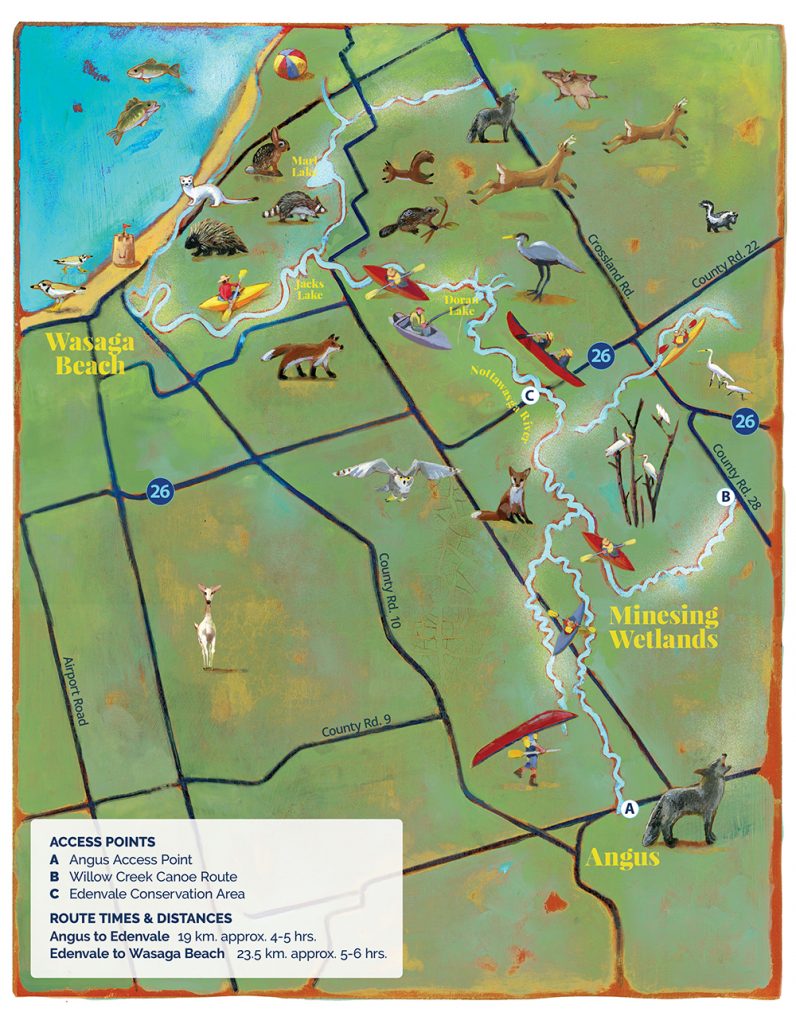 Here are some tips for paddling the Nottawasaga River:
Here are some tips for paddling the Nottawasaga River:
- Simcoe County recently released a free Nottawasaga Paddling Guide, available online at https://bit.ly/2IDVKpd. The Nottawasaga Valley Conservation Area also has a detailed guide and map at www.nvca.on.ca/recreation/canoeing-the-nottawasaga
- While the river is easy to follow in most sections, we took a GPS just to be sure of our whereabouts. A cell phone is also a good idea in case of emergency.
- For a long paddle like ours, make sure you pack sufficient food, snacks and water, as well as bug repellent and rain gear (just in case the weather turns).
- If you are thinking of paddling through the Minesing Wetlands (up-river from our Edenvale put-in), you need to be aware of water levels and consider using a guide, as it is easy to get turned around in this section of the watershed.
- For guided tours, you can find more information about Eagle Adventures at www.eagleadventureexperiences.com and Free Spirit Tours at www.freespirit-tours.com.
General Safety Tips:
- Know how to swim.
- Wear your life jacket/PFD at all times.
- Know the symptoms and treatment for hypothermia, one of the leading causes of canoeing deaths.
- Be prepared. Carry an extra paddle and PFD, first aid kit, throw line, bailer, sound signalling device, waterproof flashlight, good quality map of the area and compass. Dry clothes and extra food and water are also good to pack.
- Let at least one responsible person know where you are going and when you are expected to return.
- Take care around rapids, especially if you are new
to paddling. - Think twice before paddling the Nottawasaga in the early spring. High water levels, cold temperatures, strong currents and floating debris are common, and make paddling extremely dangerous.
- Watch for deadheads (partially submerged logs), which are common along the paddling routes.
- Use caution when you enter or leave your boat, as high muddy banks are common along most of Nottawasaga.
- Winds can generate large waves quickly on open water such as Georgian Bay, Jacks Lake, or parts of the Minesing Wetlands during periods of high water. Stay close to shore in such situations.
For more safety tips, maps and paddling guides, go to www.nvca.on.ca/recreation/canoeing-the-nottawasaga.






